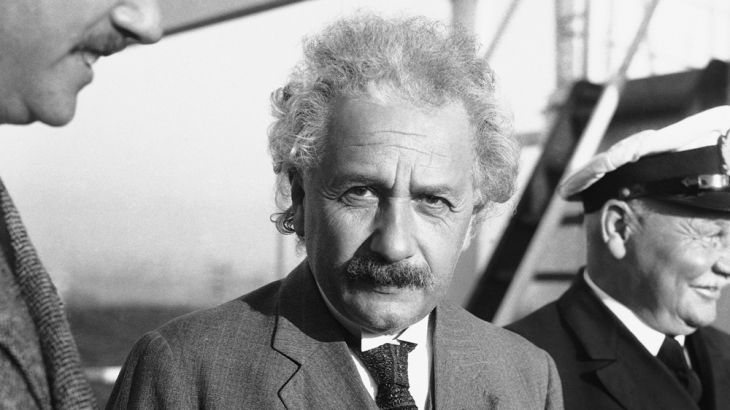100 years of General Relativity
The theory revolutionised our understanding of gravity, light and time, and paved the way for many modern technologies.

On November 25, 1915, 35-year old German-born Albert Einstein presented a series of equations to the Prussian Academy of Sciences.
They were an attempt by him to broaden the scope of his more limited, but now more famous, special theory of relativity, best known by the formula E=MC2, published 10 years earlier.
Keep reading
list of 4 itemsHong Kong’s first monkey virus case – what do we know about the B virus?
Why will low birthrate in Europe trigger ‘Staggering social change’?
The Max Planck Society must end its unconditional support for Israel
He did this by adding the force of gravity to the equation, and thereby making it possible to predict how the mass of objects and the force of their gravity can bend light and how this can alter the passage of time.
“Space and time are not are not what most of us think they are in everyday life,” said Jeffrey Bennett, author of the book What is Relativity?
“Einstein showed that they are linked together in what he called spacetime and everything we do in our lives is embedded in what we call this fabric of space-time for the Universe.”
Although initially only discussed in academic circles, Einstein’s theory got its first major test in 1919 during a solar eclipse.
He correctly predicted that the light of a distant star would be visible during the eclipse, because it had been refracted by the effect of gravity from our sun.
His successful predictions were widely publicised and his theory fast became the most important idea in modern physics.
Dark Matter
The way in which light is bent or distorted by the gravitational force of a star or galaxy – known as gravitational lensing and now widely observed by space telescopes – allowed Einstein to predict the existence of “back holes”.
By understanding how gravity affects the motion of light, astrophysicists were able to calculate the mass of objects in space, although they soon discovered those that were visible were not massive enough to explain the distortions they saw.
This led them to conclude that some additional matter existed and, although unseen, was having an effect on the motion of the light.
That matter was called dark matter, and has now been calculated to make up more than a quarter of the Universe.
“The amount of gravity that came from the stars which are in that galaxy would not be enough to produce that distortion,” said astrophysicist Francisco Diego, from University College London.
“You need extra mass that you cannot see and that mass is called dark matter. The analysis of dark matter comes because Einstein predicted this affect, and thanks to that we can quantify how much dark matter there is in the universe.”
GPS technology
Einstein’s equations on relativity are also the basis of the GPS – global positioning technology – found in smartphones and used widely for navigation.
Based on his theory, the speed of the satellite and effect of Earth’s gravity on it make any clock on board a GPS satellite run slightly faster than a clock on Earth.
Without making adjustments to compensate for this, the GPS system would be unable to track positions with any accuracy.

“Time is actually running slightly differently on those satellites than it is on the ground,” said Bennett.
“Your GPS devices actually calculate that time difference and if they didn’t you’d be truly lost because it wouldn’t get you to where you wanted to go.”
Einstein also helped develop gyroscopic compasses – a type of non-magnetic compass based on a fast-spinning disc and rotation of the Earth – which are still used on ships.
World View
The publication of Einstein’s theory of general relativity, and the confirmation of certain part of it, also marked the beginning of a period that would see him become a superstar and one of the most well-known thinkers of the 20th century.
After moving to the US in 1933, he initially supported the development of nuclear weapons.
Later, after their use in World War II, he campaigned against them.
He was also a vocal supporter of human and civil rights, his outspoken anti-nationalist and humanist stance making him one of the first pop stars.
“Those were topics that really moved many people all over the world, said Jakob Messerli, director of Bernisches Historisches Museum, home of the Einstein Museum.
“He had a credibility and also the pop-star looks. Also his personality. I don’t think he intended to be a pop star, but he really fitted perfectly well into this need for a pop star.”
Einstein’s theory of general relativity was also expressed in a more personal way in some of the tens of thousands of personal letters he wrote.
In these, he urged people to see their actions and lives in a broader context, and to realise the potential each individual has to make the world a better place.
“If everybody realised that if the things we do every day are a permanent part of the universe from that moment on, I think everybody would treat each other better and try to make sure they were making a mark on the universe that they were proud of instead of one that might embarrass them,” said Bennett.
Many aspects of Einstein’s theory of general relativity have been tested and found to hold true.
The last of his unproven predictions – existence of gravitational waves – is set to be tested by a European Space Agency probe due to launch next week.
“Relativity has been so well-tested, there’s no way it could ever turn out to be incorrect,” said Bennett.
“But what we do know is there is probably some limitations to it. I would guess in 100 years we’ll have another theory that is even broader than Einstein’s, but Einstein’s will still be intact.”